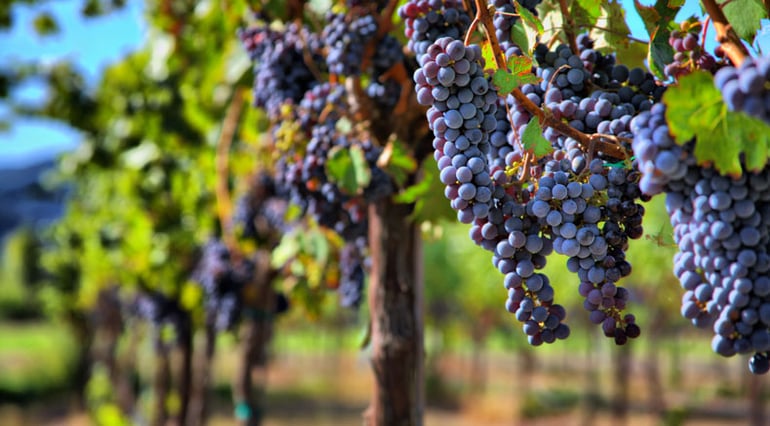
Vineyard managers, viticulturists and winemakers know it’s difficult to maintain conditions that support healthy growth and quality harvest of grapes. To ensure the well-being of grapevines, it’s necessary to keep a close watch on environmental factors like temperature, humidity and soil moisture. Without this diligence, the operation stands to lose not only the money invested in the plants, but also the profit from anticipated wine sales.
Because environmental conditions differ throughout the vineyard, it's challenging, if not impossible to conduct field inspections to manually monitor every area around the clock. And these variable conditions make local weather forecasts unreliable because their geographical points of reference don’t always reflect what is happening in the vineyard.
Installing a remote monitoring system lets users access real-time data from right where the plants are located, so they can take the necessary measures to protect plants from dangerous heat, cold and humidity. When the remote monitoring system detects sensor readings outside of the preset range, it sends a notification via phone call, text or email to designated personnel. They can then take fast action to protect the plants from excessive temperatures and prevent serious damage across the vineyard.
Cloud-based remote monitoring systems also store unlimited sensor data from the field to help operators identify condition trends. Real-time and historical data enable operators to adapt their procedures to conditions for more effective crop management.
Frost Protection
Monitoring air temperature and humidity near the vines can also help protect against frost. When readings enter into the danger zone, vineyard managers receive real-time alerts and can quickly activate frost protection measures. The temperature range being measured needs to be adjusted in relation to a vine’s cold hardiness and state of dormancy. Simply put, dormant winter buds can resist colder temperatures than new tender spring growth.
Frost damages the vines and buds when it causes ice to form within the plant tissues. One method to protect vines against frost is by using overhead water sprinklers. This rapid, constant spray of water forms a frozen coating around the buds and shoots that protects them from frost damage. That’s because the water releases heat when it changes from liquid to solid. Data from temperature sensors and humidity sensors lets operators know when they need to both turn on and turn off the sprinklers.
Vineyard operators also use wind machines as a frost prevention measure. Wind machines pull down warmer air from above the colder layer surrounding the plants, which raises the temperature around the sensitive buds. Because every degree and minute are critical, using temperature and humidity sensors is key to giving personnel enough time to get to the vineyard and activate the fans to mitigate the risk of frost damage. Even if the wind machines have sensors and auto starts, a remote monitoring system alerts users before temperatures reach dangerous lows, giving them time to act before it’s too late.
In addition to helping vineyard operators save their crops, using a remote monitoring system also helps them save money. Because both sprinkler systems and wind machines are expensive to run, knowing the precise time to begin and end the operation of this equipment means spending less on energy costs.
Heat Mitigation
Extreme heat can damage delicate flowers and grapes themselves, especially as they become more mature and ready to harvest, leading to a catastrophic loss. By using a remote monitoring system and temperature sensors, vineyard operators can determine the measures necessary to reduce fruit exposure. Temperature data can provide the information needed to determine proper heat mitigation methods like irrigation, pruning, canopy management and protective particle film.
Humidity and Moisture Control
Moisture exists all around the plants — in the atmosphere, precipitation, soil and vines themselves. Humidity sensors and soil moisture sensors are an important part of a vineyard water management plan. Monitoring humidity is vital to preventing mold and mildew from destroying the fruit and vines. Analyzing trends in humidity data helps growers identify early warnings of conditions that are ideal for fostering disease.
Information from soil moisture sensors helps operators develop the right irrigation plan for each section of the vineyard at different seasons. Data from these sensors is important in determining how much water is needed and how often. It also can help growers learn which plants are using the most water and which areas of soil draw or retain more water than others.
Data Logging
Data history is valuable in identifying patterns and trends in environmental conditions. Many monitoring systems automatically save information, recording tens of thousands of data points, dates and times. Cloud-based data logging provides an unlimited number of records for users to view, graph, print and export data trends. Analyzing data samples may lend insight into larger issues and prevent problems before they arise. For example, the historical data could help to identify specific areas of the vineyard topography that are more prone to frost and extreme heat during certain times of the day, week, month and year.
If you have questions about choosing and installing a remote monitoring system at your vineyard, our experts would be happy to help you select the best solution for your operation.







